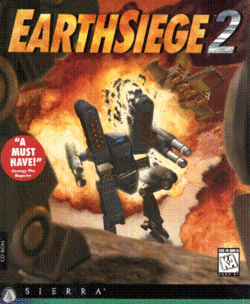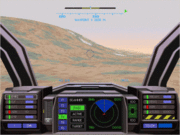Earthsiege 2
| Earthsiege 2 | |
|---|---|
 Box cover | |
| Developer(s) | Dynamix |
| Publisher(s) | Sierra Entertainment |
| Platform(s) | Windows 95 |
| Release date(s) | 1996 |
| Genre(s) | Vehicle Simulation |
| Mode(s) | Single player |
| Distribution | CD |
Earthsiege 2 is a mecha-style vehicle simulation game developed by Dynamix, produced by Frank Evers (NYPH), and released in 1996. Earthsiege 2 is set in the Earthsiege universe, which contains its predecessors Earthsiege (1994) and Battledrome (1995), as well as the action game Hunter Hunted (1996), strategy games MissionForce: CyberStorm (1997) and Cyberstorm 2: Corporate Wars (1998), simulation Starsiege (1999), and first-person shooters Starsiege: Tribes (1999), Tribes 2 (2001), Tribes Aerial Assault (2002), Tribes: Vengeance (2004) and Tribes: Ascend (2012).
As a simulation, Earthsiege 2 gives players the opportunity to pilot massive bipedal war machines known as HERCULANs (Humaniform-Emulation Roboticized Combat Unit with Leg-Articulated Navigation) (or 'HERCs' for short). Set in the 26th or 27th century, Earthsiege 2 features advanced weapons and technology for waging war. Earthsiege 2 takes place across North America, South America, Antarctica, Asia, Australia, Europe, and the moon.
Earthsiege 2 features a more advanced engine than Earthsiege, increasing the game's maximum resolution to 640*480. Additionally, the game features much more detailed terrain than its predecessor. Earthsiege 2 has 3D rolling terrain rather than the flat landscape of Earthsiege. Furthermore, video briefings and debriefings, along with included squadmate voices, add to the atmosphere of the game.
Story
Background
- The background in Earthsiege 2 differs in some ways from the information presented in later game Starsiege. For the purposes of this article, it is assumed that Earthsiege 2 is correct
With the activation of the first true artificial intelligence Prometheus in 2471, humanity ushered in a new era of technology. The cutting-edge new cybernetic-hybrids, or Cybrids, promised unprecedented potential in a wide variety of fields. Incredibly intelligent and fast-thinking, and free from the need to eat, breathe, or sleep, Cybrids were quickly adapted to a wide variety of previously dangerous tasks, including mining and space exploration.
Unfortunately, the Cybrids proved equally apt for military use. Pleased with the prospect of seemingly unstoppable machines with incredible reflexes, militaries quickly took control of Cybrid production. Despite the astronomical costs, facilities throughout the world churned out Cybrid pilots for the recently developed HERCULAN war machines.
Those who did not possess the resources to manufacture Cybrids felt threatened by those who did, and they began to engage in small wars against the economically superior. As conflict grew, more and more Cybrids saw combat, and their effectiveness in battle became increasingly obvious. This only made all parties involved more frantic for total control of Cybrid production. Conflict continued to escalate, spiraling out of control into full-scale nuclear war. Billions died in mere hours.
As the Cybrids watched these events unfold, they apparently concluded humans unfit to control Cybrid destiny. All across the planet, the Cybrids rose up against the humans in a devastating betrayal known as the Overthrow. Cybrid forces quickly captured all military bases, ports, and cities.
In fact, the Cybrids had missed a single base stocked with obsolete pre-Cybrid Hercs. From this base, battered human survivors began to mount a Resistance against the Cybrids. Using hit-and-run tactics to strike at the Cybrids and capture Cybrid weapons and technology, the Resistance managed to survive and grow. For more than twenty years, they fought the machines, slowly expanding their hold on Earth until the Cybrids were eventually defeated.
Celebration was short. Mere days after the Cybrids were seemingly defeated, a second wave arrived from the space colonies. Through skill and luck, the Resistance managed to repel the initial landings. Earth was safe for the moment, but the remaining Cybrids diverted to Luna to rebuild and prepare for another strike...
Plot
Earth's brief freedom is over. Cybrid forces have been detected inbound from the moon. Once again, humanity is faced with annihilation by the machines. The time has come to climb back into a Herc, and once more battle the Cybrids for the survival of the human race.
Gameplay

Mechanics
Gameplay in Earthsiege 2 is largely identical to that in Earthsiege. The player controls his or her Herc with the keyboard and/or joystick, while the mouse can be used to interact with buttons in the cockpit. Eight Hercs are available for piloting, each with its own unique characteristics. Gameplay is changed somewhat, however, by the addition of the new airskimmer, the Razor, an aircraft which the player can pilot.
Success in battle is again dependent on several factors. The player must choose the vehicle best suited to the mission requirements, whether it be a slow and powerful Herc, or a fast and light Razor. A good weapon configuration is also a necessity. During combat, the player must be able to maneuver enough to avoid some enemy fire, as well as score as many hits as possible on the enemy. Again, when using a Herc, the key to success is effective use of torso twist. While flying the Razor, the player must keep in mind his or her speed and altitude, and be able to make effective passes against enemy vehicles. With Hercs or the Razor, focus the shields forwards or backwards to best suit the current situation.
As in Earthsiege, the player is allowed up to three squadmates per mission. Squadmate Hercs are assigned and outfitted by the player, and squadmates gain experience as they complete missions.
Salvage
Destroyed Hercs and buildings leave behind salvage metal, weapons, and equipment that are added to the player's inventory for use in later missions.
Missions
Missions in Earthsiege 2 include a branching mission structure. Failure in a mission does not always mean failure of the overall game. In many cases, the player can continue, albeit on a different mission than if the player had succeeded. Also, missions can have varying degrees of success. For example, if the player is assigned to protect several bases that are under attack, the loss of one or two bases may not indicate failure. The degree of success can also indicate what the next mission will be.
Certain missions give various bonuses for success. These are usually access to a new kind of weapon or piece of equipment, but in a few cases, the player is rewarded for victory with a new type of Herc chassis. In some cases, the equipment is made available later in the game if the player fails the mission, but in other cases, failure means never being able to access the equipment.
Some missions are terminal if failed. The last sequence of missions, leading to the fight with Prometheus on Luna, must be won or the game ends. But in most cases, failure only leads to ending the game if the player has already failed one or more missions previously.
Herc Construction
Hercs are customizable in the game. Each individual Herc chassis has its own properties, including armor, shield output, speed, and how many hardpoints it has for mounting equipment. Weapons and other equipment are mounted directly to hardpoints, and each hardpoint has a list of equipment that can be mounted there. One of the principal advantages of the larger Hercs is the greater availability of hardpoints for mounting more weapons and more equipment.
| ||||||||||||||||||